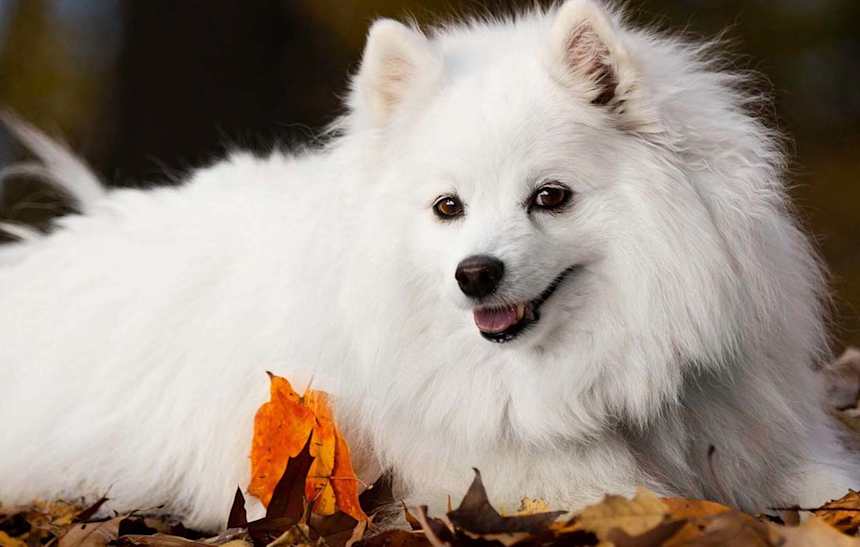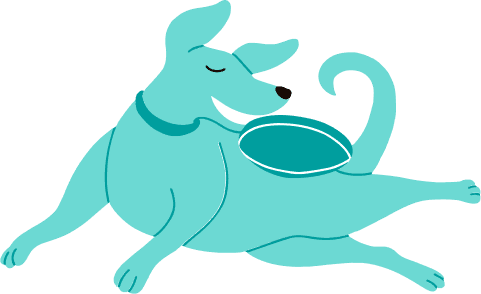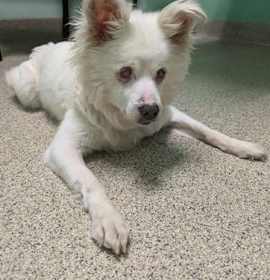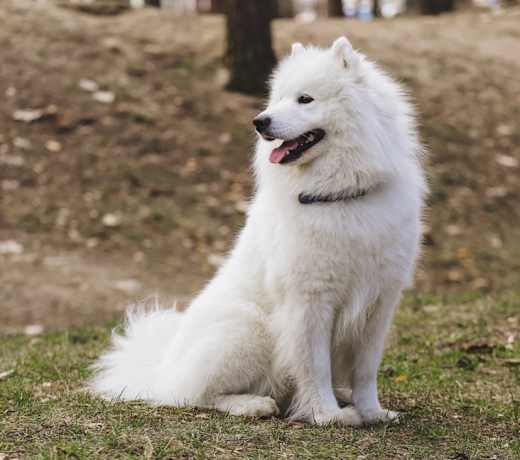American Eskimo Dogs’ size varies based on their type. Toy American Eskimo Dogs weigh between six and 10 pounds and stand between 9 and 12 inches tall; Miniature American Eskimo Dogs weigh between 10 and 20 pounds and stand 12 to 15 inches tall; and Standard Eskimo Dogs weigh between 25 to 30 pounds and stand 15 to 19 inches tall.
American Eskimo Dog
Breed Type: Non-Sporting
Common nicknames: Eskie, Eskimo Spitz, American Spitz, The Dog Beautiful
Coat: Double
Hypoallergenic: No, they will likely trigger allergies.
Temperament: Affectionate, intelligent, playful, independent
Life expectancy: 13-15 years
Color & patterns: White

American Eskimo Dogs are like walking snowballs with their pristine white coats and bright, twinkling eyes. But don’t be fooled by their angelic appearance because these pups — who come in three sizes, ranging from toy to standard and standing at around nine to 19 inches tall — are bursting with energy and mischief. If you’re looking for a pup who is equal parts playful and smart, the American Eskimo is your ticket to a lifetime of laughter and fun. Originating from Germany (despite their name), American Eskimo Dogs were bred to be versatile working dogs. They were used in circuses, as watchdogs, and even as performers in trick shows. These pups are quick learners and excel in various activities, including obedience and agility, but are also affectionate and devoted to their families, making them wonderful companions and watchful guardians.
American Eskimo Dog characteristics
Learn about about American Eskimo Dog basics like their fur colors, shedding levels, how much grooming they need, and other American Eskimo Dog facts.
Average height
9-19 inches (22.9-48.3cm)
Average weight
16-30 pounds (7.3-13.6 kg)
Average lifespan
13-15 years
Exercise needs
Grooming needs
Full-grown size
Good with cats
Good with kids
Training aptitude
How much do American Eskimo Dogs shed?
American Eskimo Dogs are moderate to heavy shedders. Their dense coat requires regular grooming to avoid becoming matted, but it’s nothing a regular brushing can’t handle.
What colors do American Eskimo Dogs come in?
American Eskimo Dogs are always white in color. They’re beloved, playful snowballs of energy.
When do American Eskimo Dogs stop growing?
American Eskimo Dogs stop growing between 12 to 18 months of age. During their early development, it’s crucial to provide them with proper nutrition and care to support their healthy development.
Where did American Eskimo Dogs originate?
The American Eskimo Dog originated in Germany and is a descendant of the German Spitz and various Nordic dogs. The breed was brought to the United States by German immigrants in the early 20th century and was originally known as the “American Spitz.” During World War I, the breed’s name was changed to “American Eskimo Dog” due to anti-German sentiment.
Contrary to what their name might suggest, the American Eskimo Dog was never used as a sled dog. As versatile working dogs, they excel at guarding, hunting, and herding livestock.
How many types of American Eskimo Dogs are there?
There are three types of American Eskimo Dogs: Toy, Miniature, and Standard. In fact, the American Eskimo Dog has the largest size variation of any breed of dog.
How long do American Eskimo Dogs live?
American Eskimo Dogs typically live 13 to 15 years. Proper care and attention to their health, including plenty of exercise, a balanced diet, and regular veterinary check-ups will help ensure a long and healthy life.
Can you shave American Eskimo Dogs?
No, you can’t shave American Eskimo Dogs. The American Eskimo Dog’s double coat helps regulate their body temperature, keeping them cool in the summer and warm in the winter. Shaving interferes with this natural insulation and may lead to skin issues, including sunburn. Instead of shaving, regular grooming and brushing can remove loose fur and prevent matting.
American Eskimo Dog temperament
Learn about about the American Eskimo Dog temperament and how well they fit into your lifestyle, home environment, and family.
Are American Eskimo Dogs good with kids?
Yes, American Eskimo Dogs are good with kids. They’re extremely affable, good-natured, and affectionate, gentle playmates to children.
As with any breed, it is recommended that your child is always supervised when interacting with your dog to keep both the child and dog safe. Teaching children how to properly approach and handle dogs is also crucial to ensure positive experiences for both the dog and the child, as is teaching dogs how to interact gently with children.
Are American Eskimo Dogs easy to train?
Yes, American Eskimo Dogs are easy to train due to their keen intelligence and desire to please. They respond well to positive reinforcement techniques such as treats, praise, and rewards.
However, training any dog takes substantial time and effort, regardless of breed. American Eskimo Dogs can have a stubborn streak, so pet parents should be prepared to practice firm and consistent training methods. Early socialization and obedience training will help prevent behavioral issues in American Eskimo Dogs and ensure they are well-behaved companions.
Do American Eskimo Dogs bark a lot?
American Eskimo Dogs bark to alert their pet parents of anything out of the ordinary. They were bred to protect property and people. As with any dog, they can be discouraged from barking with proper training and plenty of exercise.
Are American Eskimo Dogs good family dogs?
Yes, American Eskimo Dogs are great family dogs. Kind, smart, and playful, as well as eager to please, American Eskimo Dogs thrive in a family environment. They do best with daily exercise, so an active family is the best match for this breed.
Are American Eskimo Dogs good with cats?
Yes, American Eskimo Dogs are good with cats. Of course, every dog and cat has a unique personality and temperament, but pet parents can feel reasonably confident about cats and American Eskimo Dogs getting along, especially if properly socialized and/or introduced at a young age.
Do American Eskimo Dogs get along with other dogs?
Yes, American Eskimo Dogs get along with other dogs if they’ve been socialized from a young age. Like any breed, individual personalities, experience, and environment play a significant role in how they interact with other dogs. Introduce an American Eskimo Dog to other dogs in a controlled and positive environment to ensure good socialization skills. Positive reinforcement and attentive observation will help promote good relationships with other dogs.
How smart are American Eskimo Dogs?
American Eskimo Dogs are very smart. Quick learners with problem-solving abilities, American Eskimo Dogs excel at a variety of training activities and tasks, such as canine sports, circuses, and performers in trick shows. Boredom is the enemy of a smart breed like the American Eskimo Dog, so keep yours mentally stimulated to head off doggie ennui and any possible behavioral issues.
Are American Eskimo Dogs cuddly?
Yes, American Eskimo Dogs are cuddly, affectionate, and loving companions. They are especially loyal and devoted to their families, often seeking out physical affection and closeness. If cozying up on the couch or in bed is a favorite pastime, an American Eskimo Dog will make an eager snuggle buddy.
Are American Eskimo Dogs good for first-time pet parents?
Yes, American Eskimo Dogs are a good choice for first-time pet parents, provided they are prepared. While these dogs are super-smart and eager to please, they also possess a strong independent streak. Expect to be firm and consistent with your training, and a first-time parent will be very happy with an American Eskimo Dog.
To keep your energetic and playful American Eskimo Dog happy and healthy outside and in, they’ll need regular exercise and lots of mental stimulation. Their thick double coat requires regular grooming to prevent matting and tangles. If parents are prepared for training, lots of activity, and regular grooming, American Eskimo Dogs make joyful, devoted companions.
Are American Eskimo Dogs good for apartments?
Yes, American Eskimo Dogs are good for apartments as long as potential pet parents consider a few factors. First, with their playful and energetic natures, they’ll need regular exercise to stay happy and healthy. Daily walks, playtime, and mental stimulation will prevent boredom and potential behavior issues in close quarters. American Eskimo Dogs also have a tendency to bark, which the neighbors might not love. Proper training and socialization can mitigate this behavior, but it’s something to keep in mind when considering bringing an American Eskimo Dog home to your apartment.
Can American Eskimo Dogs swim?
Yes, American Eskimo Dogs can swim, but they might not like it. Some American Eskimo Dogs may enjoy swimming and take to it easily, while others may be hesitant or even afraid of the water.
When introducing your American Eskimo Dog to swimming, start slowly and offer lots of positive experiences in the water. Always supervise your dog while they are swimming to ensure their safety. You may even consider using a doggy life jacket for added protection, especially if they are not strong swimmers. With patience, encouragement, and proper training, many American Eskimo Dogs can learn to enjoy swimming and have fun in the water.
Are American Eskimo Dogs good guard dogs?
Yes, American Eskimo Dogs are good guard dogs. Alert, intelligent, and protective of their families, these natural watchdogs bark to alert their parents of any potential threats or strangers near their homes. American Eskimo Dogs are not typically aggressive or overly territorial, so they won’t likely offer much physical protection. Instead, they will signal if there is potential danger.
Do American Eskimo Dogs like snow?
Yes, American Eskimo Dogs like snow. Their thick double coat protects and insulates them from frigid temperatures, and they love to romp in the cold.
Even with a natural affinity for snow and ice, pay attention to the time your American Eskimo Dog spends in the snow to prevent them from getting too cold, becoming dehydrated, or experiencing any discomfort.
American Eskimo Dog health
Learn about about the American Eskimo Dog health outlook and what diseases they may be prone to at various stages of their life.
Do American Eskimo Dogs have a lot of health problems?
American Eskimo Dogs are prone to health issues including:
Hip and/or elbow dysplasia: Hip and elbow dysplasia are two of the most common skeletal diseases seen in dogs. They are similar diseases in which either the hip or elbow joint has grown abnormally or is misshapen. The abnormal shape prevents the joints and sockets from properly meeting one another, resulting in rubbing and grinding instead of sliding smoothly. Unlike in hip dysplasia, where the main problem is joint instability, elbow dysplasia often results in pieces of bone and/or cartilage breaking loose and irritating the joint tissues. Over time, the rubbing from dysplasia can cause a variety of issues such as pain, lameness, and secondary osteoarthritis. Surgery can fix the joint if diagnosed before the onset of arthritis. If you are rescuing an American Eskimo dog, have them checked out by a vet to see if they have or are prone to getting dysplasia.
Legg-Calve-Perthes: This condition causes the head of the femur (located in a dog’s hind leg) to spontaneously degenerate. Over time, this will lead to erosion of the hip joint and arthritis. An American Eskimo Dog suffering from Legg-Calve-Perthes will become lame, limp while walking, and experience pain when moving the hip joint. Surgery is the most effective treatment for the disorder.
Progressive retinal atrophy (PRA): PRA is a group of genetic diseases that affect the retina. They are progressive degenerative diseases and will eventually cause blindness in both eyes. There is no effective treatment to stop PRA.
Juvenile cataracts: Cataracts are a common eye condition that causes cloudiness in the eye and obstructs vision. With juvenile cataracts, symptoms appear before the age of six. Juvenile onset cataracts are likely hereditary.
Others: Some other conditions seen in American Eskimo dogs include patellar luxation, a common problem in many dog breeds that causes the knee joint to slide in and out of place, and diabetes.
Are American Eskimo Dogs hypoallergenic?
No, American Eskimo Dogs are not hypoallergenic. Their thick double coat sheds year-round, which can contribute to allergens in the home.
While no dog breed is completely hypoallergenic, people with allergies may react less to American Eskimo Dogs compared to breeds with more dander or shedding. Regular grooming and maintenance can help reduce the amount of loose fur and dander in your house, potentially making it easier for those with allergies to live with an American Eskimo Dog.
Popular American Eskimo Dog mixes
There are several breeds commonly mixed with American Eskimo Dogs to create hybrid breeds, including:
American Eagle Dog (American Eskimo Dog + Beagle)
Baskimo (American Eskimo Dog + Basset Hound)
Bichomo (American Eskimo Dog + Bichon Frise)
Boskimo (American Eskimo Dog + Boston Terrier)
Coton Eskimo (American Eskimo Dog + Coton de Tulear)
Eskipoo (American Eskimo Dog + Poodle)

Find American Eskimo Dog puppies near you
Adopting an American Eskimo Dog
Learn about acquiring an American Eskimo Dog - the pros and cons of adopting versus going through a breeder, and associated costs.

Lucy
American Eskimo Dog
Female, senior
Marina Del Ray, CA
Good with dogs
Good with cats
Needs special attention
House-trained
Spayed or Neutered
Shots are up-to-date

BUDDY
American Eskimo Dog Pomeranian
Male, 9 yrs
Downey, CA
Good with dogs
Good with cats
House-trained
Spayed or Neutered
Shots are up-to-date

Lucy
American Eskimo Dog
Female, senior
Marina Del Ray, CA
Good with dogs
Good with cats
Needs special attention
House-trained
Spayed or Neutered
Shots are up-to-date

BUDDY
American Eskimo Dog Pomeranian
Male, 9 yrs
Downey, CA
Good with dogs
Good with cats
House-trained
Spayed or Neutered
Shots are up-to-date


